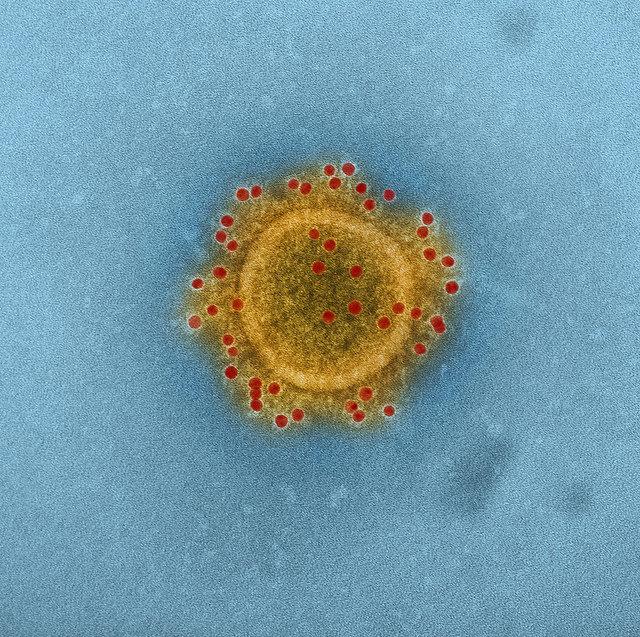Experimental MERS vaccine shows promise in animal studies

This is a colorized micrograph of the MERS coronavirus. Credit: NIAID
Vaccinated mice produced broadly neutralizing antibodies against multiple strains of the MERS coronavirus (MERS-CoV), while vaccinated macaques were protected from severe lung damage when later exposed to MERS-CoV.
The findings suggest that the current approach, in which vaccine design is guided by an understanding of structure of viral components and their interactions with host cells, holds promise for developing a similar human MERS vaccine regimen.
Currently, no licensed vaccines are available for MERS, a disease that first appeared in 2012. An outbreak in the Republic of Korea that began in May has caused more than 180 confirmed infections, including 36 deaths, through July 15 as well as widespread social disruption.
The research team was led by Barney S. Graham, M.D., Ph.D., Wing-Pui Kong, Ph.D., and colleagues at the National Institute of Allergy and Infectious Diseases' Vaccine Research Center.
The investigators used structural information about a viral protein called the spike (S) glycoprotein, which MERS-CoV uses to enter cells, to design a number of experimental vaccines that they administered to mice in a two-step regimen involving an initial “priming” injection followed several weeks later by the same or a different “booster” vaccine.
The three prime-boost regimens that elicited the most robust immune responses in mice were then tested in groups of macaques and were found to elicit similar immune system responses. A separate group of 18 macaques (12 vaccinated, six unvaccinated) were exposed to MERS-CoV 19 weeks after the vaccinated animals received the boost injection.
Although macaques do not develop overt MERS disease, the researchers observed that unvaccinated animals experienced lung abnormalities indicative of pneumonia that were more profound and longer lasting than those seen in the vaccinated animals. The team is now working on refining the vaccine candidates and may eventually test a second-generation vaccine candidate in clinical trials.
###
ARTICLE: L Wang et al. Evaluation of candidate vaccine approaches for MERS-CoV. Nature Communications DOI: 10.1038/ncomms8712 (2105).
NIAID Director Anthony S. Fauci, M.D., and Dr. Barney Graham, deputy director, Vaccine Research Center, NIAID, are available to comment.
CONTACT: To schedule interviews, please contact Anne A. Oplinger, (301) 402-1663, aoplinger@niaid.nih.gov.
NIAID conducts and supports research–at NIH, throughout the United States, and worldwide–to study the causes of infectious and immune-mediated diseases, and to develop better means of preventing, diagnosing and treating these illnesses. News releases, fact sheets and other NIAID-related materials are available on the NIAID website.
About the National Institutes of Health (NIH): NIH, the nation's medical research agency, includes 27 Institutes and Centers and is a component of the U.S. Department of Health and Human Services. NIH is the primary federal agency conducting and supporting basic, clinical, and translational medical research, and is investigating the causes, treatments, and cures for both common and rare diseases. For more information about NIH and its programs, visit http://www.
NIH…Turning Discovery Into Health®
Media Contact
All latest news from the category: Health and Medicine
This subject area encompasses research and studies in the field of human medicine.
Among the wide-ranging list of topics covered here are anesthesiology, anatomy, surgery, human genetics, hygiene and environmental medicine, internal medicine, neurology, pharmacology, physiology, urology and dental medicine.
Newest articles

Bringing bio-inspired robots to life
Nebraska researcher Eric Markvicka gets NSF CAREER Award to pursue manufacture of novel materials for soft robotics and stretchable electronics. Engineers are increasingly eager to develop robots that mimic the…

Bella moths use poison to attract mates
Scientists are closer to finding out how. Pyrrolizidine alkaloids are as bitter and toxic as they are hard to pronounce. They’re produced by several different types of plants and are…

AI tool creates ‘synthetic’ images of cells
…for enhanced microscopy analysis. Observing individual cells through microscopes can reveal a range of important cell biological phenomena that frequently play a role in human diseases, but the process of…





















